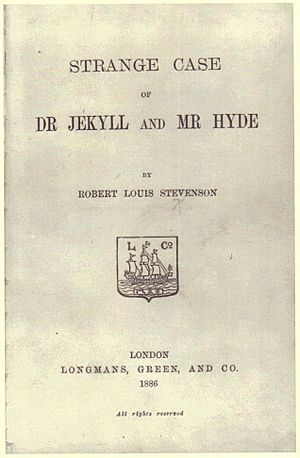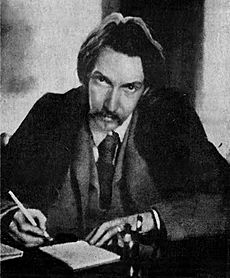Strange Case of Dr Jekyll and Mr Hyde facts for kids

Title page of the first London edition (1886)
|
|
| Author | Robert Louis Stevenson |
|---|---|
| Original title | Strange Case of Dr Jekyll and Mr Hyde |
| Country | United Kingdom |
| Language | English |
| Genre |
|
| Publisher | Longmans, Green & Co. |
|
Publication date
|
5 January 1886 |
| Pages | 141 (first edition) |
| ISBN | 978-0-553-21277-8 |
Strange Case of Dr Jekyll and Mr Hyde is an exciting and spooky story written in 1886 by a Scottish author named Robert Louis Stevenson. It's about a London lawyer, Gabriel John Utterson, who tries to figure out some strange things happening between his old friend, Dr. Henry Jekyll, and a dangerous man called Edward Hyde.
This story is one of the most famous books in English literature. It helped define the "Gothic horror" style, which often includes mystery, suspense, and supernatural elements. The phrase "Jekyll and Hyde" is now used to describe someone who seems good on the outside but sometimes acts surprisingly mean or evil.
Contents
How the Story Was Created

Robert Louis Stevenson was always interested in how people can have both good and bad sides to their personality. Even when he was a teenager, he thought about these ideas. He wrote a play about a real person named William Brodie, who was a respected craftsman by day but a thief at night. This idea of a "double life" was something Stevenson explored a lot.
The story was written in a town called Bournemouth in England. Stevenson moved there in 1884 because the sea air and warmer weather were good for his health. He became friends with a man named Walter Jekyll, who was a former minister. Stevenson borrowed the name "Jekyll" from him.
Stevenson himself said that he got the idea for the story from a dream. His wife, Fanny Stevenson, remembered waking up one night because Louis was crying out in horror. She woke him up, and he was upset, saying, "Why did you wake me? I was dreaming a fine bogey tale." He had been dreaming about the first time Dr. Jekyll changed into Mr. Hyde.
His stepson, Lloyd Osbourne, said that Stevenson wrote the first draft of Dr. Jekyll incredibly fast, possibly in just three days!
The Story's Rewrite
After Stevenson wrote the first version, his wife, Fanny, read it. She thought the story was more like an allegory, which is a story with a hidden meaning, often about morals or politics. But Stevenson had written it just as an exciting tale.
Some stories say that Stevenson was so frustrated by her comments that he burned the first manuscript! He then started over from scratch, writing the story as an allegory, just as his wife had suggested. Whether he truly burned it or not, he definitely rewrote the story very quickly, in about three to six days, and then spent several weeks making it even better.

What Happens in the Story
The story begins with Gabriel John Utterson, a lawyer, and his cousin, Richard Enfield, taking their usual walk. They pass a mysterious door, and Enfield tells a strange story about it. Months ago, he saw a mean-looking man named Edward Hyde accidentally knock over a young girl. Hyde was forced to pay the girl's family a lot of money to avoid trouble. Hyde got the money by giving Enfield a check signed by a respected gentleman: Dr. Henry Jekyll, who is Utterson's friend.
Utterson becomes worried because Dr. Jekyll recently changed his will to leave everything to Hyde if Jekyll dies or disappears. Utterson thinks Hyde might be blackmailing Jekyll. When Utterson tries to talk to Jekyll about Hyde, Jekyll says he can get rid of Hyde whenever he wants and asks Utterson to leave it alone.
The Murder and Mystery
A year later, a servant sees Hyde brutally kill an old man named Sir Danvers Carew, who was also Utterson's client. Hyde leaves behind half of a broken walking cane. The police contact Utterson, who leads them to Hyde's apartment. Hyde is gone, but they find the other half of the broken cane, which Utterson recognizes as one he gave to Jekyll.
Utterson visits Jekyll, who shows him a note supposedly from Hyde, apologizing for the trouble. However, Utterson notices that Hyde's handwriting looks very similar to Jekyll's. This makes Utterson think that Jekyll might be trying to protect Hyde by faking the note.
For a couple of months, Jekyll seems to go back to his normal, friendly self. But then, he suddenly stops seeing visitors. Dr. Hastie Lanyon, a friend of both Jekyll and Utterson, becomes very sick and dies from shock after learning something terrible about Jekyll. Before he dies, Lanyon gives Utterson a letter to be opened only after Jekyll's death or disappearance.
Later, Utterson and Enfield are on another walk and see Jekyll at his laboratory window. Jekyll suddenly slams the window shut and disappears, which worries Utterson even more.
Uncovering the Truth
Jekyll's butler, Mr. Poole, visits Utterson, saying Jekyll has been locked in his laboratory for weeks and seems different. Utterson and Poole break into the lab. Inside, they find Hyde's body, wearing Jekyll's clothes. They also find two letters: one from Lanyon and one from Jekyll.
Lanyon's letter explains that he became sick from shock because he saw Hyde drink a special liquid that turned him into Jekyll!
Jekyll's letter explains everything. He says that he always tried to act like a good, moral person in public, but he had secret desires and felt ashamed of them. He found a way to create a special liquid that would transform him. This way, he could act on his secret desires without anyone knowing it was him. When he transformed, he became Hyde: a smaller, younger, completely evil, selfish, and uncaring person.
At first, Jekyll could control when he changed using the liquid. But one night, he changed into Hyde without meaning to, while he was asleep. Jekyll decided he had to stop becoming Hyde. However, one night he felt weak and drank the liquid again. Hyde, who had been "locked up" for so long, then committed the terrible murder of Sir Danvers Carew.
Jekyll was horrified and tried even harder to stop the transformations. But then, he started changing into Hyde without drinking the liquid, even when he was awake. Since the police were looking for Hyde as a murderer, Hyde needed help. He wrote to Lanyon (in Jekyll's handwriting) asking for chemicals from his lab. In front of Lanyon, Hyde mixed the chemicals, drank the liquid, and changed back into Jekyll. Seeing this shocking transformation caused Lanyon to become ill and die.
Jekyll's involuntary transformations became more and more frequent. He needed larger and larger doses of the liquid to change back to himself. This is why he slammed the window shut on Utterson – he was changing into Hyde.
Eventually, the special salt needed for the liquid ran out. New batches of the salt didn't work, making Jekyll realize that the original salt must have had a special impurity that made the transformation possible. Knowing he would soon be stuck as Hyde forever, Jekyll wrote down his full story. He ends his letter saying he doesn't know if Hyde will be caught or if he will find the courage to die, but he doesn't care because he (Jekyll) is dying soon, and whatever happens next will happen to someone else.
Main Characters
Gabriel John Utterson
Gabriel John Utterson is a lawyer and a loyal friend to Jekyll and Lanyon. He is a calm and serious man who doesn't show much emotion. However, he is trustworthy, accepts others' flaws, and is generally well-liked. He becomes very curious about Mr. Hyde and tries to understand the strange connection between Hyde and his friend, Dr. Jekyll.
Dr. Henry Jekyll / Mr. Edward Hyde
Dr. Jekyll and Mr. Hyde (character) Dr. Jekyll is a respected, well-built man in his fifties. He lives in London and often feels like he is fighting between the good and evil parts of himself. He spent much of his life trying to hide his bad urges because they didn't fit with his respectable image.
He creates a special liquid to separate this hidden evil from his personality. When he drinks it, he transforms into Edward Hyde. Hyde is smaller, younger, cruel, and completely evil. Jekyll has many friends and a kind personality, but as Hyde, he is mysterious and violent. Over time, Hyde becomes stronger. Eventually, Jekyll no longer needs the liquid to turn into Hyde; Hyde can appear on his own. In the end, Hyde becomes so powerful that Jekyll needs the liquid just to stay conscious as himself.
Richard Enfield
Richard Enfield is Utterson's cousin. He is a well-known man about town. He is the first person to tell Utterson about Edward Hyde, after seeing Hyde run over a little girl in the street. Enfield and other witnesses made Hyde pay the girl's family. Enfield found out that Dr. Jekyll had signed the check, and it was real. He says Hyde looks disgusting but can't quite describe why.
Dr. Hastie Lanyon
Dr. Lanyon is a long-time friend of Jekyll. He doesn't agree with Jekyll's unusual scientific ideas, calling them "too fanciful." He is the first person to discover Hyde's true identity when Hyde transforms back into Jekyll right in front of him. Lanyon's letter helps Utterson solve the mystery. After witnessing the shocking transformation and hearing Jekyll's confession, Lanyon becomes very ill and later dies from the shock.
Mr. Poole
Poole is Dr. Jekyll's loyal butler. He has worked for Jekyll for many years. Poole becomes very worried about Jekyll's strange behavior and how he hides away in his laboratory. Fearing that his master has been murdered and that Mr. Hyde is living in Jekyll's rooms, Poole goes to Utterson for help. He bravely helps Utterson break down the laboratory door to find out the truth.
Inspector Newcomen
Inspector Newcomen is a Scotland Yard police inspector. Utterson joins him after Sir Danvers Carew is murdered. They investigate Hyde's apartment in London and find clues about his life.
Sir Danvers Carew, MP
Sir Danvers Carew is a kind, 70-year-old Member of Parliament. A maid sees Hyde violently kill Carew in the streets of London. Carew is carrying a letter addressed to Utterson when he dies, and half of Jekyll's broken walking stick is found near his body.
Maid
A maid, who had seen Hyde visit her employer before, is the only witness to Sir Danvers Carew's murder. She saw Hyde kill Carew using Jekyll's cane and his feet. After fainting from the shock, she wakes up and rushes to the police, which starts the investigation into Carew's murder.
Other Versions of the Story
Adaptations of Strange Case of Dr. Jekyll and Mr. Hyde The story of Dr. Jekyll and Mr. Hyde has been told in many different ways. There have been over 120 stage plays and movies based on the book!
Many people have also recorded audio versions of the story, including famous actors like Tom Baker, Christopher Lee, and John Hurt.
A musical based on the story, called "Jekyll & Hyde," was created in 1990. There have also been several video games inspired by the tale, such as "Jekyll and Hyde" by MazM.
Illustrated Books
Some editions of the book have special drawings. S. G. Hulme Beaman illustrated a version in the 1930s. In 1948, Mervyn Peake created memorable illustrations for the Folio Society's edition of the story.
See also
 In Spanish: El extraño caso del doctor Jekyll y el señor Hyde para niños
In Spanish: El extraño caso del doctor Jekyll y el señor Hyde para niños

